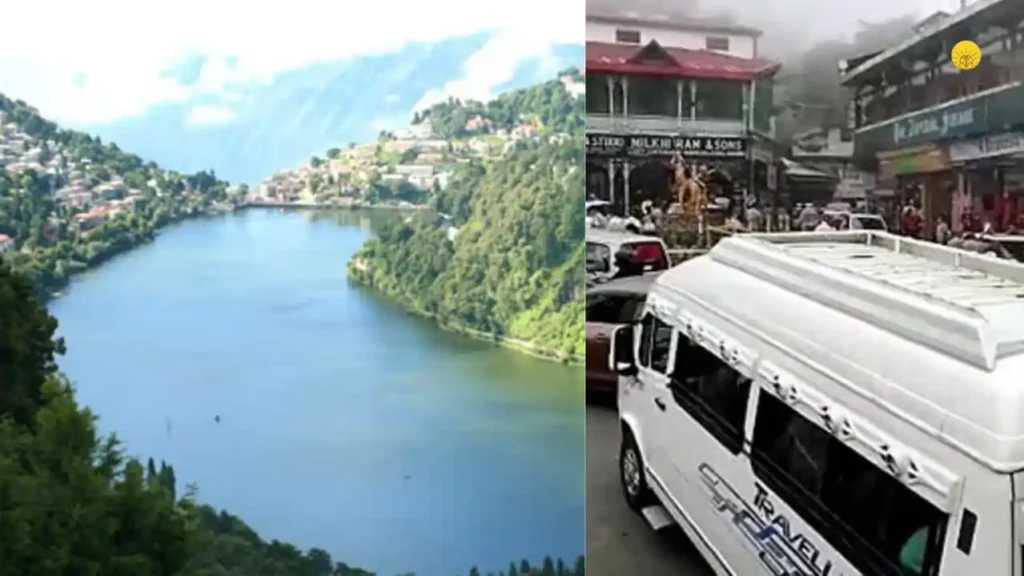New Delhi: In a groundbreaking move, Uttarakhand has embarked on a first-of-its-kind initiative to assess the Tourist Carrying Capacity of Nainital District, a popular destination in the Kumaon region known for its scenic hill stations, serene lakes, and lush greenery. This strategic survey, announced in July 2025, aims to formulate a long-term plan to safeguard the region’s fragile ecosystem and iconic hill towns from the mounting pressures of unregulated tourism, escalating vehicular traffic, and growing population demands. The initiative marks a significant step toward sustainable tourism and environmental conservation in one of India’s most beloved tourist destinations.

Background: Why Assess Tourist Carrying Capacity in Nainital?
Nainital District, home to picturesque hill stations like Nainital, Bhimtal, and Naukuchiatal, attracts millions of tourists annually. The region’s natural beauty, characterized by serene lakes, dense forests, and panoramic Himalayan views, makes it a hotspot for domestic and international travelers. However, this influx has led to significant challenges, including environmental degradation, traffic congestion, water scarcity, and strain on local infrastructure.
The decision to assess the district’s carrying capacity stems from a directive issued by the National Green Tribunal (NGT) in September 2024. The NGT, a specialized body for environmental disputes, instructed the Uttarakhand state government to classify Nainital District based on its carrying capacity and environmental sensitivity. This directive was a response to growing concerns about the ecological toll of unchecked tourism and urbanization in the region. The NGT emphasized the need for a scientific approach to balance tourism-driven economic growth with the preservation of Nainital’s delicate ecosystem.
The survey, initiated in 2025, is designed to address these concerns by determining the maximum number of tourists and residents the district can sustainably support without compromising its natural resources, infrastructure, or quality of life. By establishing a clear framework for tourism management, Uttarakhand aims to set a precedent for other Indian states grappling with similar challenges.
What is Carrying Capacity?
Carrying capacity refers to the maximum threshold of population—both human and tourist—that an area can sustain in relation to its available resources. This concept is rooted in ecological and environmental science and is influenced by a combination of biotic and abiotic factors.
- Biotic factors include elements such as vegetation, wildlife, and hydrology (e.g., water bodies like Nainital Lake). These living components are critical to maintaining the ecological balance of the region.
- Abiotic factors encompass non-living elements like terrain, climate, and soil conditions, which also play a pivotal role in determining how much pressure an area can withstand.
In the context of Nainital, carrying capacity assessment will evaluate how many visitors the district can accommodate without causing irreversible harm to its forests, water systems, air quality, or cultural heritage. For instance, excessive tourism could lead to deforestation, pollution of lakes, or depletion of groundwater, all of which threaten the long-term viability of the region as a tourist destination.
Methodologies for Assessing Carrying Capacity
The Uttarakhand government has outlined two primary approaches for assessing carrying capacity in Nainital District, each offering unique insights into the region’s sustainability challenges:
1. Planetary Boundaries Approach
The planetary boundaries approach is a globally recognized framework used to assess environmental crises such as global warming, land degradation, pollution, and water stress. This method identifies critical thresholds beyond which human activities could destabilize the Earth’s ecosystems. In Nainital, this approach will involve analyzing factors such as:
- Air and water quality: Measuring pollution levels in Nainital Lake and other water bodies, as well as air quality affected by vehicular emissions.
- Land use patterns: Evaluating the impact of construction, deforestation, and urban sprawl on the district’s terrain and biodiversity.
- Climate resilience: Assessing how climate change affects rainfall patterns, temperature, and the availability of resources like water and vegetation.
By applying the planetary boundaries framework, the survey will identify “safe operating spaces” for tourism and development, ensuring that Nainital’s ecosystems remain within sustainable limits.
2. Biocapacity Overshoot Approach
The biocapacity overshoot approach focuses on the sustainability of human consumption relative to the Earth’s natural systems. It measures the demand humans place on resources by calculating how quickly the planet’s annual productivity (e.g., crops, forests, fisheries) is consumed. A key metric in this approach is Earth Overshoot Day, the date when humanity’s demand for ecological resources exceeds what the Earth can regenerate in a year.
In Nainital, this approach will assess how tourism and population growth contribute to resource depletion. For example, the influx of tourists increases the demand for water, food, and energy, which can strain local resources if not managed properly. By calculating the district’s biocapacity, authorities can determine whether current tourism levels are sustainable or if they are pushing the region toward an “overshoot” scenario.
The Role of the Precautionary Principle
A cornerstone of the carrying capacity assessment is the precautionary principle, which guides decision-making in the face of uncertainty. This principle emphasizes proactive measures to prevent environmental harm, even when scientific evidence is incomplete. The document outlines four key components of the precautionary principle for Nainital’s survey:
- Taking Preventive Actions in the Face of Uncertainty: Rather than waiting for definitive proof of environmental damage, authorities will act preemptively to limit tourism and development activities that could harm Nainital’s ecosystems.
- Shifting the Burden of Proof: Proponents of tourism-related projects (e.g., hotels, resorts, or infrastructure) must demonstrate that their activities will not exceed the district’s carrying capacity or cause environmental harm.
- Exploring Alternatives to Potentially Harmful Actions: The survey will consider alternative tourism models, such as eco-tourism or low-impact travel, to minimize strain on resources.
- Increasing Public Participation in Decision-Making: Local communities, environmentalists, and stakeholders will be involved in shaping tourism policies, ensuring that the assessment reflects diverse perspectives.
By adhering to the precautionary principle, Uttarakhand aims to create a robust framework for sustainable tourism that prioritizes long-term environmental health over short-term economic gains.
Significance of Carrying Capacity in Sustainable Development
The assessment of carrying capacity is a critical tool for achieving sustainable development in Nainital District. It provides a scientific basis for resolving the ongoing conflict between developmental governance (e.g., promoting tourism for economic growth) and the sustainability of development (e.g., preserving natural resources for future generations).
Key benefits of the carrying capacity assessment include:
- Environmental Protection: By setting clear limits on tourism and population growth, the survey will help protect Nainital’s forests, lakes, and biodiversity from overexploitation.
- Infrastructure Planning: Understanding the district’s capacity will guide investments in roads, water supply, waste management, and other infrastructure to ensure they meet demand without collapsing under pressure.
- Community Well-Being: Limiting overcrowding and resource depletion will improve the quality of life for residents, who often face water shortages and traffic congestion during peak tourist seasons.
- Economic Sustainability: A balanced approach to tourism will ensure that Nainital remains an attractive destination for years to come, supporting long-term economic growth.
The survey’s findings will inform policies such as tourist quotas, vehicle restrictions, and sustainable land-use planning, creating a model for other hill stations in India facing similar challenges.
Challenges and Future Outlook
While the initiative is a significant step forward, implementing the carrying capacity assessment will not be without challenges. Key hurdles include:
- Data Collection: Accurately measuring biotic and abiotic factors across Nainital’s diverse terrain requires extensive data collection and scientific expertise.
- Stakeholder Coordination: Balancing the interests of tourists, local businesses, residents, and environmentalists will require transparent and inclusive decision-making.
- Enforcement: Enforcing tourism limits and environmental regulations may face resistance from stakeholders who rely on tourism revenue.
Despite these challenges, the survey represents a forward-thinking approach to tourism management. By prioritizing sustainability, Uttarakhand is positioning Nainital as a model for responsible tourism in India. The initiative could inspire other states, such as Himachal Pradesh and Jammu & Kashmir, to adopt similar strategies for their hill stations.
Conclusion
Uttarakhand’s decision to assess the Tourist Carrying Capacity of Nainital District is a landmark effort to address the growing pressures of unregulated tourism, vehicular traffic, and population growth. Guided by the National Green Tribunal’s directive and grounded in scientific methodologies like the planetary boundaries and biocapacity overshoot approaches, the survey aims to create a sustainable framework for tourism and development. By adhering to the precautionary principle and involving local communities, the initiative ensures that Nainital’s natural beauty and ecological health are preserved for future generations.
As the survey progresses, it will serve as a blueprint for balancing economic growth with environmental conservation, offering valuable lessons for other tourist destinations in India and beyond. For travelers, residents, and policymakers, this initiative underscores the importance of sustainable tourism in safeguarding the planet’s most cherished destinations.
Frequently Asked Questions
1. What is the purpose of assessing the tourist carrying capacity in Nainital District?
The assessment aims to formulate a long-term strategy to protect Nainital’s hill towns from the pressures of unregulated tourism, heavy vehicular traffic, and population growth. It seeks to ensure sustainable tourism by determining the maximum number of visitors the district can support without harming its environment, resources, or infrastructure.
2. What is meant by ‘carrying capacity’ in this context?
Carrying capacity refers to the maximum population, including tourists and residents, that Nainital District can sustain based on its available resources. It considers biotic factors (e.g., vegetation, hydrology) and abiotic factors (e.g., terrain, climate) to prevent environmental degradation and ensure long-term sustainability.
3. What approaches are being used to assess Nainital’s carrying capacity?
Two main approaches are being utilized:
- Planetary Boundaries Approach: Analyzes environmental crises like global warming, pollution, and water stress to identify sustainable limits for tourism and development.
Biocapacity Overshoot Approach: Measures human demand on natural resources, using metrics like Earth Overshoot Day, to assess whether tourism levels exceed the district’s ecological capacity.
4. How does the precautionary principle guide this assessment?
The precautionary principle involves taking preventive actions despite uncertainties, shifting the burden of proof to project proponents, exploring less harmful alternatives, and increasing public participation. This ensures that tourism policies prioritize environmental protection and sustainability in Nainital.
5. Why is this assessment significant for sustainable development?
The assessment helps balance developmental goals, like tourism-driven economic growth, with environmental conservation. By setting limits on tourism and guiding infrastructure planning, it protects Nainital’s ecosystems, improves residents’ quality of life, and ensures the region remains a viable tourist destination for future generations.

